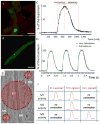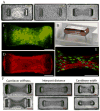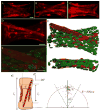Formation and optogenetic control of engineered 3D skeletal muscle bioactuators
- PMID: 22976544
- PMCID: PMC3586563
- DOI: 10.1039/c2lc40338b
Formation and optogenetic control of engineered 3D skeletal muscle bioactuators
Abstract
Densely arrayed skeletal myotubes are activated individually and as a group using precise optical stimulation with high spatiotemporal resolution. Skeletal muscle myoblasts are genetically encoded to express a light-activated cation channel, Channelrhodopsin-2, which allows for spatiotemporal coordination of a multitude of skeletal myotubes that contract in response to pulsed blue light. Furthermore, ensembles of mature, functional 3D muscle microtissues have been formed from the optogenetically encoded myoblasts using a high-throughput device. The device, called "skeletal muscle on a chip", not only provides the myoblasts with controlled stress and constraints necessary for muscle alignment, fusion and maturation, but also facilitates the measurement of forces and characterization of the muscle tissue. We measured the specific static and dynamic stresses generated by the microtissues and characterized the morphology and alignment of the myotubes within the constructs. The device allows testing of the effect of a wide range of parameters (cell source, matrix composition, microtissue geometry, auxotonic load, growth factors and exercise) on the maturation, structure and function of the engineered muscle tissues in a combinatorial manner. Our studies integrate tools from optogenetics and microelectromechanical systems (MEMS) technology with skeletal muscle tissue engineering to open up opportunities to generate soft robots actuated by a multitude of spatiotemporally coordinated 3D skeletal muscle microtissues.
Figures




Similar articles
-
Fabrication of skeletal muscle constructs by topographic activation of cell alignment.Biotechnol Bioeng. 2009 Feb 1;102(2):624-31. doi: 10.1002/bit.22080. Biotechnol Bioeng. 2009. PMID: 18958861 Free PMC article.
-
Optogenetic Calcium Ion Influx in Myoblasts and Myotubes by Near-Infrared Light Using Upconversion Nanoparticles.ACS Appl Mater Interfaces. 2023 Sep 13;15(36):42196-42208. doi: 10.1021/acsami.3c07028. Epub 2023 Aug 31. ACS Appl Mater Interfaces. 2023. PMID: 37652433 Free PMC article.
-
Engineering a 3D in vitro model of human skeletal muscle at the single fiber scale.PLoS One. 2020 May 6;15(5):e0232081. doi: 10.1371/journal.pone.0232081. eCollection 2020. PLoS One. 2020. PMID: 32374763 Free PMC article.
-
Engineered skeletal muscle tissue for soft robotics: fabrication strategies, current applications, and future challenges.Wiley Interdiscip Rev Nanomed Nanobiotechnol. 2014 Mar-Apr;6(2):178-95. doi: 10.1002/wnan.1254. Epub 2013 Dec 6. Wiley Interdiscip Rev Nanomed Nanobiotechnol. 2014. PMID: 24319010 Review.
-
Engineering strategies for the construction of oriented and functional skeletal muscle tissues.Biofabrication. 2025 Mar 28;17(2). doi: 10.1088/1758-5090/adbfc2. Biofabrication. 2025. PMID: 40073456 Review.
Cited by
-
Measuring cell-generated forces: a guide to the available tools.Nat Methods. 2016 Apr 28;13(5):415-23. doi: 10.1038/nmeth.3834. Nat Methods. 2016. PMID: 27123817 Free PMC article. Review.
-
Long-Term Cryopreservation and Revival of Tissue-Engineered Skeletal Muscle.Tissue Eng Part A. 2019 Jul;25(13-14):1023-1036. doi: 10.1089/ten.TEA.2018.0202. Epub 2019 Jan 9. Tissue Eng Part A. 2019. PMID: 30412045 Free PMC article.
-
In vitro formation and extended culture of highly metabolically active and contractile tissues.PLoS One. 2023 Nov 1;18(11):e0293609. doi: 10.1371/journal.pone.0293609. eCollection 2023. PLoS One. 2023. PMID: 37910543 Free PMC article.
-
Bioengineered Skeletal Muscle as a Model of Muscle Aging and Regeneration.Tissue Eng Part A. 2021 Jan;27(1-2):74-86. doi: 10.1089/ten.TEA.2020.0005. Epub 2020 Jun 16. Tissue Eng Part A. 2021. PMID: 32364045 Free PMC article.
-
Integrating in vitro organ-specific function with the microcirculation.Curr Opin Chem Eng. 2014 Feb 1;3:103-111. doi: 10.1016/j.coche.2013.12.004. Curr Opin Chem Eng. 2014. PMID: 24729953 Free PMC article.
References
-
- McMahon TA. Muscles, reflexes, and locomotion. Princeton Univ Press; Princeton, NJ: 1984.
-
- Van Ham R, Sugar TG, Vanderborght B, Hollander KW, Lefeber D. Compliant actuator designs. IEEE Robotics and Automation Magazine. 2009;16:81–94.
-
- Dennis RG, Herr H. Biomimetrics: biologically inspired technologies. CRC Press; New York, NY: 2005. pp. 243–266.
-
- Feinberg AW, Feigel A, Shevkoplyas SS, Sheehy S, Whitesides GM, Parker KK. Muscular Thin Films for Building Actuators and Powering Devices. Science. 2007;317:1366–1370. - PubMed
Publication types
MeSH terms
Substances
Grants and funding
LinkOut - more resources
Full Text Sources
Other Literature Sources

